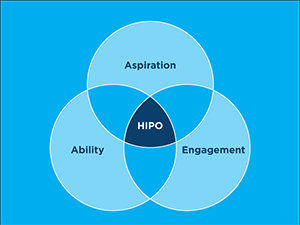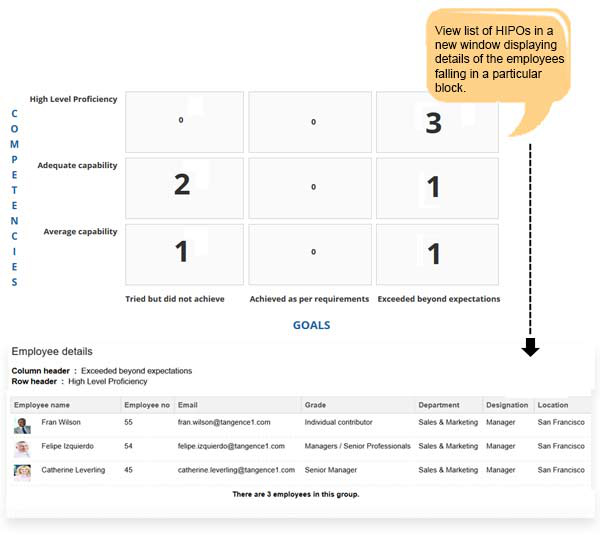High potential employees, or commonly known as HIPOs, are 50% more valuable to an organization than other employees, as they exhibit 21 percent higher productivity levels. CEB data shows that HIPOs contribute 91% more in achieving business goals.

As shown in the image, a high-potential employee has the capability, aspiration and commitment to take organizational success to the next level. Engagement, aspiration, and ability are three main characteristics that make HIPOs the most valuable assets for an organization.
When an organization talks about mid-to-long-term growth strategies and focuses on future business growth plans, it needs a pool of talented employees who can convert those goals to reality. High potential employees are the people who have the ability to lead an organization to that growth. However, if these employees are not developed and nurtured, their value may erode quickly.
That’s where challenges to identify, engage and retain high-potential employees magnify manifold.
- High Attrition: CEB states that the turnover rate of high-potential employees is 30% and more than 50% of organizations are ineffective at identifying, managing, and retaining top talent.
- Low Performance: The Corporate Leadership Council reported that 40% HIPOs have insignificant performance levels. 40% of internal job moves by HIPOs end in failure and >15% of direct reports are ready for immediate transition to subsequent roles.
Organizations invest millions of dollars to train and develop high potential employees. There is no point of conducting HIPO programs, if you are inviting and training the wrong people. Managers, HR and the leaderships often worry about identifying the right set of employees within the workforce and implementing effective ways to nurture, engage & retain them. They are often seen sharing concerns like –
Are we investing resources in the right employees?
Why is our company’s HIPO program not working effectively?
What is the best way to prepare high potential employees to take more challenging roles?
Why we are unable to engage and retain high potential employees? Why are we losing them?
Identifying truly high potential talent is a necessity for a successful business. More than half of the organizations lack a systematic process to identify HIPOs, and the others are unable to get best from the potential of this top talent.
Engagement of high potential employees increases current level of performance and lowers employee attrition rate in an organization. Thus, each organization should focus on engaging and retaining HIPOs.
How To Get More From a HIPO Program?
Spending resources on the non-HIPO employees will not get you anywhere. So, make sure your next HIPO program focuses on truly high potential talent.
As already stated, an employee who is a top performer with three promising characteristics should be considered as a true high potential employee –
- Aspiration to reach to more challenging leadership roles within the organization.
- Ability to effectively manage responsibilities of senior job roles.
- Engagement to stay committed to organizational as well as individual goals.
Where to begin?
Define Talent Pools
Start looking for potential successors in each department within your organization to build talent pipeline and fill key leadership positions. Find out the abilities, personality traits, competencies, and values required to fulfil each talent pool. Assess high potential employees based on these characteristics and assign them to suitable talent pool.
Identify High Potential Talent
Organizations should carefully implement performance management process to identify HIPOs. Integrate performance appraisal system with succession planning tools to continuously evaluate performance, commitment, and capabilities of potential employees. Managers can also rate an employee’s potential and readiness to take a key leadership role. The performance potential graph, like 9-grid box, enables HR to collect data and identify HIPOs on the basis of manager ratings and comments.

Develop High Potential Staff
Almost 2/3rd of HIPOs (64%) say that they are dissatisfied with their development experiences, and over two-thirds of HIPO programs (69%) have failed to build a strong pipeline of leaders to take over from their firm’s current crop. {Source CEB Global}
On-the-job training opportunities enable top performers to build competencies and learn from experiences. Providing only formal training to HIPO may not help them completely. As we know learning comes from experience, a HIPO development program should focus on providing challenging experiences to the employees. High potential employees should be involved in tasks where their full potential can be realized and they can contribute towards organizational goals.
To develop HIPOs, HR and managers should create individual development plans which may include mentoring as well as formal training programs.
Focus On Engagement
Getting the best outcomes from an employee is the top priority of a manager. If a manager believes in “They know I appreciate them, there’s no need to tell my team members that they are good!” and ignores the efforts of his team members, it may drive low engagement. Managers and HR need to focus on creating a work culture where motivation, reward and recognition exist. It may engage high potential talent in many ways.
Retain HIPOs
Ask your high potential employees on how they plan to advance in their career and help them achieve their career goals. Continuous performance feedback, transparent appraisals and appreciation contribute to engagement and retention.
How Does HR Technology Help in HIPO Program?
Creating long term and proven strategies to identify, develop and retain high potential employees become most effective, when they are evidence-based. Integrated HR tools effectively manage performance data related to HIPOs and help in accurate decision making. Reliable HR software, like Empxtrack, supports organizations to manage HIPO expectations and development needs of each individual!
Now it’s your chance to think: How do you identify, manage and retain high potential employees in your organization?


